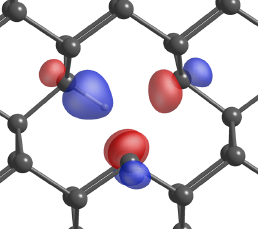 The vacancy-hydrogen defects in diamond: a computational study
The vacancy-hydrogen defects in diamond: a computational study
Hydrogen is grown into CVD diamond and occurs in point defects also involving a lattice vacancy, V. Complexes involving V, H and nitrogen, or silicon have been identified by experiment, and in some cases the microscopic structure has been identified with the use of quantum-chemical simulations. In this study, we present the results of density functional simulations of the primitive vacancy-hydrogen defect in diamond. We find that the symmetry of the VH defect is C3v, with the H atom strongly bonded to one of the four C radicals that are formed when the vacancy is created. The defect is expected to occur in both the neutral and negatively charged forms, with the possibility of both positive and −2 charge states. For VH0, S = 3/2 and S = 1/2 spin states are found to be indistinguishable in energy, with the quartet not expected to yield sharp optical transitions, unlike the doublet. VH−1 in the S = 1 ground-state is predicted to have an optical transition that is broadly similar to that of NV− (S = 1), although it is important to note that the non-degenerate band involved in the transitions arises from a different origin in VH−1 as there are no lone-pairs present in this case. We have also made predictions for the CH stretch mode frequencies, noting a general trend with charge state. Combinations of optical spectroscopy, paramagnetic resonance and vibrational mode spectroscopy are therefore required to fully experimentally resolve VH in its various charge and spin states.
Go back